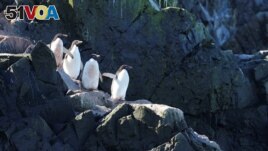04 February 2022
Scientists researching climate change in Antarctica are studying penguins in an effort to better understand the area's environmental health.
The scientists are measuring the growth and development of the penguin population on the eastern side of the Antarctic Peninsula. Reuters news agency recently reported on studies in the area carried out by two American researchers.
"We are counting penguin nests to understand how many penguins are in a colony, producing (young) every year, and whether that number is going up or down with the environmental conditions," said Alex Borowicz. He is an ecology researcher at New York's Stony Brook University.

Adelie penguins stand together as scientists investigate the impact of climate change on Antarctica's penguin colonies, on the eastern side of the Antarctic peninsula, Antarctica January 17, 2022. (REUTERS/Natalie Thomas)
The work is not easy for climate researchers in the icy, faraway reaches of Antarctica. But penguins are easier to follow than some other kinds of animals because they nest on land. Their black bodies and waste droppings can also be identified against the area's white background.
Michael Wethington, another researcher from Stony Brook, told Reuters the penguin population can represent overall climate conditions and the health of the area's whole ecosystem.
The researchers say counts of individual penguins can be combined with data from satellite images to get a more complete picture of how the animals are progressing.
Gentoo penguins – with bright orange beaks and white markings on their heads – prefer open water without broken pieces of ice floating around. So when temperatures on the Antarctic Peninsula began rising during the latter half of the 20th century, gentoo populations moved south. Some scientists called the movement the "gentoofication" of Antarctica.
David Ainley is a biologist with the ecological advisory company H.T. Harvey & Associates. He has been studying penguins for more than 50 years. "Gentoo penguins don't like sea ice," Ainley told Reuters. "They mostly forage over the continental shelf and don't go far out to sea."
As sea ice has decreased along the western side of the peninsula, gentoos seem to have gotten used to the changed conditions. But those same conditions have been worse for the Adelies penguin species. This is because the Adelies depend on sea ice for feeding and reproduction.
"When we find Adelie penguins, we typically know that sea ice is nearby," Stony Brook's Wethington said. He added that whenever researchers see sea ice decreasing or disappearing, they also see Adelie penguin populations drop sharply.
Even though Adelie penguins are increasing in number overall, some populations have fallen by more than 65 percent, researchers say.
On their January trip to the area, the Stony Brook scientists found that Adelie colonies around the still-icy Weddell Sea had remained solid during the past ten years. "This peninsula is maybe a safe space as we see climate change progressing and overall warming throughout the globe," Wethington said.
I'm Bryan Lynn.
Reuters reported on this story. Bryan Lynn adapted the report for VOA Learning English. We want to hear from you. Write to us in the Comments section, and visit 51VOA.COM.
_____________________________________________________
Words in This Story
nest – n. a home built by birds and some other creatures to hold their eggs and to live in
ecosystem – n. everything that exists in a particular environment
beak – n. the hard part of a bird's mouth
forage – v. to move around searching for things you need, especially food
species – n. a group of animals or plants that are similar and can produce young animals or plants
globe – n. the world